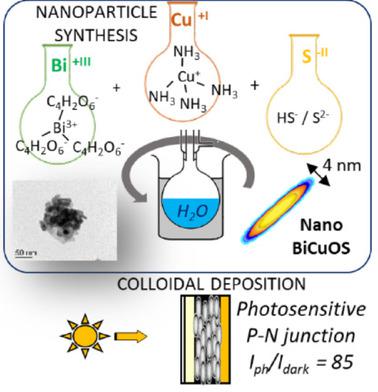当前位置:
X-MOL 学术
›
ChemPlusChem
›
论文详情
Our official English website, www.x-mol.net, welcomes your
feedback! (Note: you will need to create a separate account there.)
Aqueous‐Based Low‐Temperature Synthesis and Thin‐Film Properties of Oxysulfide BiCuOS Nanoparticles
ChemPlusChem ( IF 3.0 ) Pub Date : 2020-04-01 , DOI: 10.1002/cplu.201900733 J. Gamon 1, 2 , S. Haller 1, 2 , D. Giaume 1 , C. Robert 1 , C. M. Thomas 1 , L. D'Alençon 2 , V. Buissette 2 , T. Le Mercier 2 , P. Barboux 1
ChemPlusChem ( IF 3.0 ) Pub Date : 2020-04-01 , DOI: 10.1002/cplu.201900733 J. Gamon 1, 2 , S. Haller 1, 2 , D. Giaume 1 , C. Robert 1 , C. M. Thomas 1 , L. D'Alençon 2 , V. Buissette 2 , T. Le Mercier 2 , P. Barboux 1
Affiliation

|
BiCuOS is a nontoxic p‐type semiconductor that is a promising candidate for photoelectric applications. The formation of thin films with a good electronic transport at the grain boundaries, while avoiding thermal treatment detrimental to its chemical stability is a challenge. We have developed a chemical method for the direct synthesis of stable colloidal suspensions of BiCuOS nanoparticles from soluble precursors. These colloidal solutions were stabilized with a catechol functionalized poly‐3‐hexylthiophene that allows easy spin‐coating deposition and favors electronic transport along the grain boundaries. Stacking of ZnO–BiCuOS layers were achieved, allowing preparation of n–p junctions. These act as rectifying diodes and are strongly photosensitive, with Iph/Idark=85 corresponding to an enhancement of the photocurrent of more than two orders of magnitude compared to that of BiCuOS alone. This energy‐efficient and low‐cost method is a further step in the development of new sulfide semiconductor devices.
中文翻译:

氧硫化物BiCuOS纳米粒子的水基低温合成和薄膜性质
BiCuOS是一种无毒的p型半导体,是光电应用的有希望的候选者。形成具有良好电子传输的晶粒边界处的薄膜,同时避免对化学稳定性有害的热处理是一个挑战。我们已经开发了一种化学方法,用于从可溶性前体直接合成BiCuOS纳米颗粒的稳定胶体悬浮液。这些胶体溶液已被邻苯二酚官能化的聚3-己基噻吩稳定,可以轻松进行旋涂沉积并有利于沿晶界的电子传输。ZnO–BiCuOS层的堆叠得以实现,从而可以制备n–p结。它们用作整流二极管,并且具有强光敏性,I ph / I暗= 85,对应于与单独的BiCuOS相比,光电流增加了两个数量级以上。这种节能,低成本的方法是新型硫化物半导体器件开发的又一步。
更新日期:2020-04-22
中文翻译:

氧硫化物BiCuOS纳米粒子的水基低温合成和薄膜性质
BiCuOS是一种无毒的p型半导体,是光电应用的有希望的候选者。形成具有良好电子传输的晶粒边界处的薄膜,同时避免对化学稳定性有害的热处理是一个挑战。我们已经开发了一种化学方法,用于从可溶性前体直接合成BiCuOS纳米颗粒的稳定胶体悬浮液。这些胶体溶液已被邻苯二酚官能化的聚3-己基噻吩稳定,可以轻松进行旋涂沉积并有利于沿晶界的电子传输。ZnO–BiCuOS层的堆叠得以实现,从而可以制备n–p结。它们用作整流二极管,并且具有强光敏性,I ph / I暗= 85,对应于与单独的BiCuOS相比,光电流增加了两个数量级以上。这种节能,低成本的方法是新型硫化物半导体器件开发的又一步。









































 京公网安备 11010802027423号
京公网安备 11010802027423号